Breast cancer 92% of women feel less sick with subcutaneous therapy
Breast cancer, 92% of women feel less sick with subcutaneous therapy
According to the wave investigation, the National Observatory on Woman and Gender Health, women with Her2 breast cancer in subcutaneous therapy are forced to less renunciations from a social, familiar and working point of view by spending half the time in Day-Hospital Compared to women in intravenous therapy – Only 12 minutes for the administration of subcutaneous therapy against over 2 hours for the intravenous
Savings for the national health system of 9 million euros with the use of subcutaneous Trasuzumab, which could reach 14.7 million by increasing the share of administration to maximum eligibility, according to the Scuba project (Subcutaneous Benefit Analysis))
Breast cancer, with new therapies remarkable improvement for the experience of treatment ”
“Recent innovations that provide for the use of new subcutaneous formulations in breast cancer treatment allow a considerable improvement in the care experience for women who can halve the time spent in the hospital to undergo the therapies,” says Francesca Merzagora, president Wave, National Observatory on Women’s Health and Gender. “This allows you to reduce the impact of care on life habits and not to subtract time from social, family and work relationships”.
It is the same patients who support him through the testimonies collected in the recent wave survey aimed at photographing the diagnostic, therapeutic and assistance path with particular focus on the impact that the disease and intravenous or subcutal therapy have on the quality of life of women with cancer al breast her2+. The investigation, conducted by Elma Research with the unconditional contribution of Roche, was carried out on a sample of 101 women to whom the tumor was removed in one of the 11 Senology centers selected throughout Italy. Following the intervention, 91% said they had undergone at least an intravenous therapy and 73% to at least subcutaneous therapy in their own history history.
Difference for the time of administration of the treatment
The survey shows that only 1 in 10 women who go to the hospital for the administration of intravenous therapy do it independently, while those who undergo subcutaneous therapy, in 39% of cases are independent; This translates into a more limited impact of the woman’s disease on the caregiver. Even the time spent in Day-Hospital with the two ways of administration is very different: for those who are in intravenous therapy it is on average 5 hours, even 38% of women persist 6-10 hours; For those who undergo subcutaneous therapy, on average, on average of 2-3 hours, 50% even within 2 hours.
The main difference is given by the time of administration of the therapy which is on average for the intravenous one of 145 minutes while for the subcutaneous one is enough 12 minutes; For all patients, on the other hand, the time spent in the waiting room is very high, much more than 2 hours.
The perception of subcutaneous therapy for those who did it is excellent
It is considered less invasive, more favorable for a good quality of life, useful for saving time, comfortable for the hospital and health personnel and 92% of the interviewees believed they feel “less sick”.
From the point of social, familiar and working point of view, in fact, women subjected to subcutaneous therapy believe that the time dedicated to it has imposed less renunciations than those who have made intravenous therapy: only 23% say they have neglected aspects of family life and 20% sides of relational and social life, compared to 42% and 33% of patients who have made intravenous care; With subcutaneous therapy only 12% had to compromise work or study, against 28% of the endovenous, and 57% of them believe they have not had to do any kind of renunciation.
One woman interviewed out of 5 said she had to give up work due to the disease and as many as 38% of these made this decision precisely because of the time required by intravenous therapy.
Benefits both on the economic-organizational level
“Especially for women, who must be rugged simultaneously between the different roles of mother, housewife and worker”, continues Merzagora, “it is important to have a therapeutic innovation available that can allow them to make less renunciations and at the same time be effective “.
“In addition to the positive perception by the patients”, declares Daniele Generali, director of Multidisciplinary of breast pathology and translational research, Asst Cremona, “the new formulations bring benefits both on an economic-organizational level and on that relating to the clinical security of the treatment in diagnostic-therapeutic path “.
These confirmations come from the Scuba (Subcutaneous Benefit Analysis) project, created by BIP, Business Integration Partners with the support of Roche, which aims to analyze all the benefits and differential costs relating to the different formulations, subcutaneous and intravenous, of the Trasuzumab and Rituximab drugs respectively Suitable for the Her2+ adiuvante and metastatic breast cancer and diffuse large B -cell lymphoma and follicular lymphoma.
“From the study, which involved 49 entities for a total of 69 day-hospital throughout Italy”, he continues


